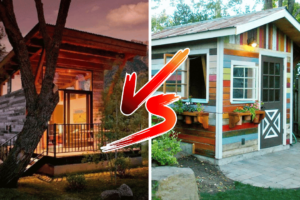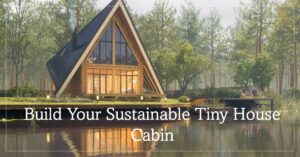Unveiling the Distinct Worlds of Tiny Houses and Shed Houses

In today’s ever-evolving housing landscape, the desire for unconventional living spaces has sparked a surge of interest in tiny houses and shed houses.
As we delve into these two unique housing concepts, we’ll uncover the subtle nuances that set them apart.
For those seeking to explore these intriguing alternatives, understanding their individual characteristics is key to making an informed decision.
The Charm of Compact Living
Tiny Houses: Imagine a life where simplicity reigns supreme. In the world of tiny houses, residents are drawn to a minimalist way of living. It’s about reducing the excess, paring down to the essentials, and discovering the joys of a clutter-free existence.
Compact, efficient, and thoughtfully designed, tiny houses epitomize the essence of downsizing. The intent behind these dwellings lies in the pursuit of simplicity and efficiency, creating spaces that are both functional and aesthetically pleasing.
Shed Houses: On the other hand, shed houses offer a different allure. Often born from existing structures, these houses are versatile spaces that cater to a variety of needs. The individuals drawn to shed houses are seeking practicality and flexibility.
Shed houses provide the means to add extra living space to an existing property without the hefty cost of traditional home additions. Here, the intent is often focused on making the most of available resources and personalizing space.
Exploring Mobility and Freedom
Tiny Houses: Mobility takes center stage in the tiny house movement. Some tiny houses are built on wheels, allowing residents to embrace a more nomadic lifestyle. Whether it’s the call of adventure or a desire to live lightly on the planet, the intent is often tied to the freedom of movement and a commitment to sustainable living.
Shed Houses: Shed houses, by contrast, are firmly rooted in place. The intent here revolves around optimizing an existing space and enhancing its functionality. Shed houses can serve as guesthouses, home offices, or creative retreats, offering a sense of independence without the need for mobility.
Sustainability and Practicality
Tiny Houses: Sustainability is a hallmark of many tiny houses. These compact homes often incorporate energy-efficient features and eco-friendly materials, aligning with the intent to minimize environmental impact. The residents of tiny houses are often driven by a commitment to sustainable living practices.
Shed Houses: While shed houses may not always be synonymous with eco-friendly features, their practicality cannot be denied. By repurposing existing structures, shed house enthusiasts are often focused on maximizing value and minimizing waste.
Below is a table outlining the pros and cons of tiny houses and shed houses:
Aspect | Tiny House | Shed House |
Pros | ||
1. Minimalist Living | Promotes simplicity and reduced clutter. | Offers versatile living space that can be expanded. |
2. Financial Freedom | Lower cost of construction, utilities, and maintenance. | Cost-effective expansion of existing property. |
3. Mobility and Adventure | Mobility, ideal for those who desire a nomadic lifestyle. | Stationary, providing stability and a sense of place. |
4. Environmental Sustainability | Smaller environmental footprint, eco-friendly designs. | Potential for sustainable practices with renovations. |
5. Reduced Maintenance | Easier to clean and maintain due to compact size. | Minimalistic design can make maintenance straightforward. |
6. Focus on Experiences | Shifts focus from material possessions to experiences. | Provides extra space for hobbies and creative pursuits. |
7. Customization | Customizable and personalized despite limited space. | Opportunities for creative conversions and adaptations. |
8. Eco-Friendly Materials | Often built using sustainable and energy-efficient materials. | Potential for eco-conscious renovations. |
9. Community Connection | Tiny house communities offer a sense of belonging. | Can be part of a larger neighborhood or community. |
Cons | ||
1. Limited Space | Very restricted living space can be challenging. | Limited to the size and layout of the existing shed. |
2. Zoning and Legal Issues | Zoning regulations may limit where you can park or build. | Building codes and permits may pose challenges. |
3. Mobility Constraints | Limited mobility, especially for non-wheeled designs. | Lack of mobility; home remains in one location. |
4. Storage Challenges | Limited storage space can be problematic for some. | Storage options may be restricted in shed conversions. |
5. Accessibility Issues | Small size may not be suitable for those with mobility issues. | Accessibility considerations for conversions. |
6. Infrastructure Needs | May require off-grid solutions for water and power. | Dependent on existing infrastructure; may need upgrades. |
7. Resale Value | Tiny houses may have limited resale value in some areas. | Shed house resale value may vary based on location. |
8. Adaptation Complexity | Building or converting may involve complex construction. | Renovations may require more extensive planning. |
The DIY Appeal
Tiny Houses: A strong DIY ethos characterizes The tiny house movement. Many tiny homeowners take pride in building their own abodes, crafting spaces that reflect their personalities and needs. The intent here is not just about living small but also about the joy of creation.
Shed Houses: Shed houses also offer a canvas for creativity, particularly regarding conversions. The intent here can be seen as a practical form of self-expression, where individuals transform humble structures into cozy havens through their efforts.
A Quest for Minimalism
Minimalism through a tiny house is often considered more desirable for several reasons:
- Simplicity and Reduced Clutter: Tiny houses force residents to simplify their lives and possessions. With limited space, individuals must carefully curate their belongings, keeping only what is essential. This can lead to a clutter-free and organized living environment, which many people find appealing.
- Financial Freedom: Tiny houses are typically more affordable than traditional homes. The lower cost of construction, utilities, and maintenance can lead to financial freedom. Tiny living offers an attractive solution for those who want to reduce debt, live mortgage-free, or save more money for other pursuits.
- Reduced Environmental Footprint: Tiny houses tend to have a smaller environmental footprint. They require fewer building materials, consume less energy for heating and cooling, and often incorporate sustainable design features. This aligns with the values of individuals who prioritize environmental sustainability and want to reduce their carbon footprint.
- Mobility and Adventure: Many tiny houses are built on wheels, allowing for mobility. This appeals to those who desire a more nomadic lifestyle or want the freedom to travel and explore different places. The ability to take your home with you can be a significant advantage for adventurers.
- Focus on Experiences Over Possessions: Tiny house living encourages a shift in priorities from acquiring possessions to accumulating experiences. With limited space for belongings, residents are prompted to invest in experiences, travel, hobbies, and relationships rather than accumulating material goods.
- Easier Maintenance: Tiny houses are easier to clean and maintain due to their compact size. This can save time and effort compared to the upkeep required for larger homes, making tiny living an attractive option for those who prefer a low-maintenance lifestyle.
- More Time for What Matters: With fewer possessions and a smaller living space, people often find they have more time and energy to dedicate to activities they are passionate about, whether that’s pursuing hobbies, spending time with loved ones, or engaging in personal growth.
- Freedom from Consumerism: Tiny house living can provide a sense of freedom from the consumer-driven culture that often encourages excess consumption. This shift away from materialism can lead to greater contentment and a focus on what truly matters in life.
- Customization and Personalization: Despite their small size, tiny houses offer ample opportunities for customization. Residents can design their tiny homes to perfectly suit their needs and preferences, creating a space that reflects their personality and lifestyle.
- Community and Connection: Many tiny house communities and events exist, fostering a sense of belonging and connection among like-minded individuals. For some, the desire to be part of a supportive community is a significant draw to tiny house living.
In summary, minimalism through a tiny house is considered more desirable by those who value simplicity, financial freedom, sustainability, mobility, and a focus on experiences over possessions. It offers a way of living that aligns with these values and can lead to a more fulfilling and intentional lifestyle.
Conclusion
In the world of alternative housing, the intent behind choosing between a tiny house and a shed house is subtly woven into the fabric of each concept.
Whether driven by a desire for minimalism, mobility, sustainability, practicality, or DIY ingenuity, these unique housing choices cater to different lifestyles and priorities.
As you embark on your housing journey, consider your own intent and how it aligns with the distinct worlds of tiny houses and shed houses. Ultimately, your choice will be a reflection of your unique aspirations and needs.

